

"Of course it's not for everybody," says Emi Takiguchi, who teaches the abacus at an after-school program in San Diego.Rachel Perera spent more than a year working four jobs to support herself and her eight-year-old daughter. (Picture: Supplied)īeing newly single, Rachel decided it would be better to move from her home in London to Manchester, where her mum lived, so she could help out more, and started working at a big PR agency in the city centre. "It's really incredible to watch," Barner says.Ī lot of kids find it much easier to compute using an abacus because it engages their visual and tactile capacities, Barner says. Chinese, Japanese and Indian kids who compete in mental abacus competitions can add up to 15 numbers in less than two seconds.

"You'll see them teasing their hands in the air as if they're holding a real abacus," Barner says. But once kids learn the basics, he says, "it can make a really significant difference in their ability to do computation."Īdvanced abacus users are able to do quick computations using even imaginary or mental abacuses. "It takes about three years to master," says David Barner, a professor of psychology at the University of California, San Diego who studies how children learn with the abacus. There, and all over Asia, abacus classes are a popular after-school activity, and teachers often use them to help kids who are struggling in math. When Singh taught in India for a stint, her students there studied with more complex Chinese and Japanese abacuses.
Abacus row jobs how to#
"It gives children a visual understanding of how to perform these operations," Singh says. Then they use it for simple counting exercises, before moving on to addition and subtraction. "The littlest ones, they just enjoy the colors of the beads," she says. Manisha Singh's 3-, 4-, 5- and 6-year-olds at Shining Stars Montessori in Washington, D.C., use a version with four rows of 10 beads each. It's the fact that they're so adaptable that makes them such a good tool for teaching. For more on that, you can find videos here and here.) (In fact, we're not even going to try to explain in a few paragraphs how they work. "You think you know, and then you come across things like this" - she points to a giant abacus made in Mexico - "and this one has 13 beads across!" "It's almost impossible to generalize how they work," Kidwell says. The Chinese and Japanese abacuses are divided into two sections beads on one side are worth one each, and beads on the other side are worth five each. They all work a bit differently, but in most cases, each row represents an order of 10 - the bottom row may represent units, the second row represents tens and then hundreds and so on.

But you can also use them to carry out a range of calculations, from simple addition and subtraction to multiplication and even square roots. The abacus can be used for basic counting, and young students can move the beads around to make shapes. Holbrook also felt that abacuses were a good way to supplement formal education in Boston primary schools.Īnd he was right. The device was especially useful for teaching young factory workers who couldn't read or write how to do simple calculations, Kidwell says. In the 1820s, inspired by teachers in Europe who were doing the same, a man called Josiah Holbrook championed for the use of simple abacuses in American schools.


 0 kommentar(er)
0 kommentar(er)
